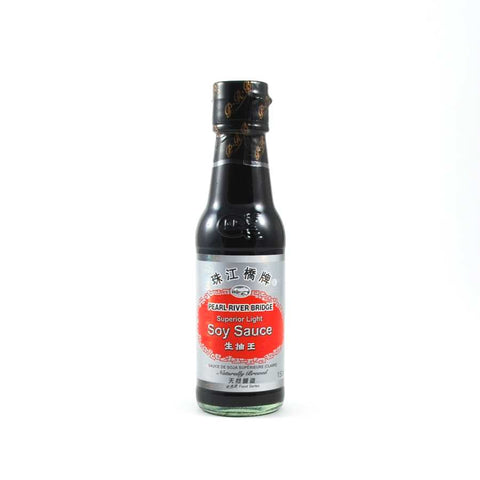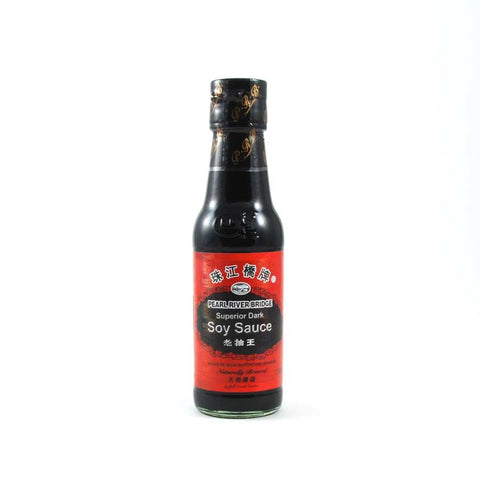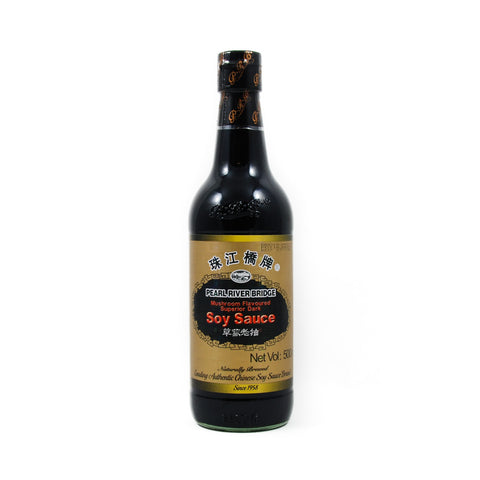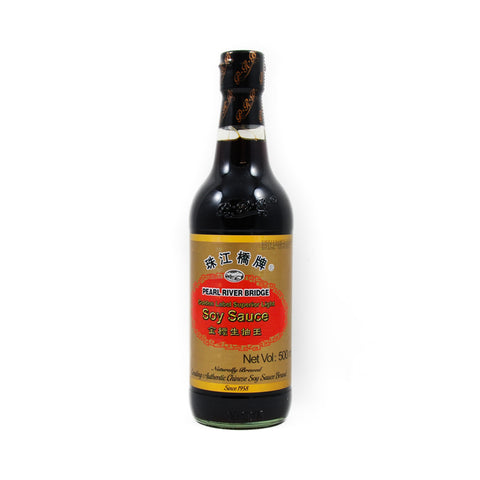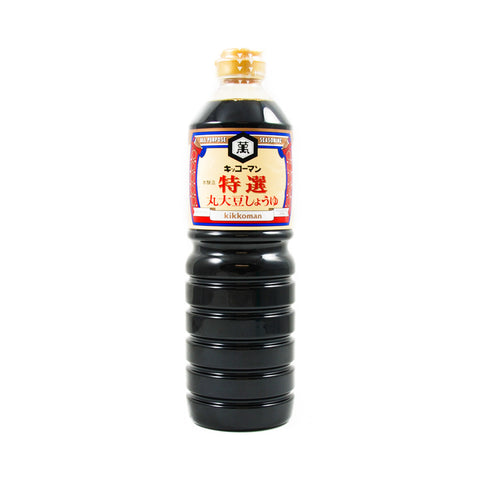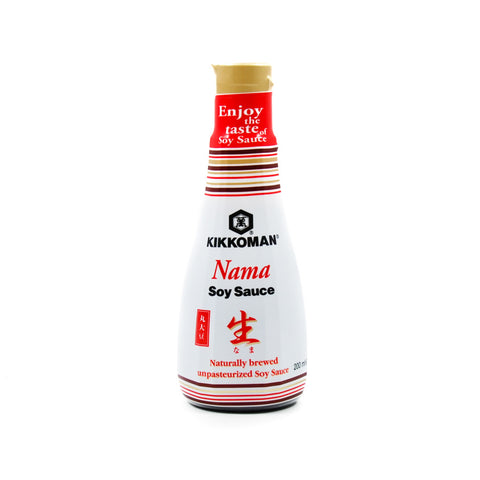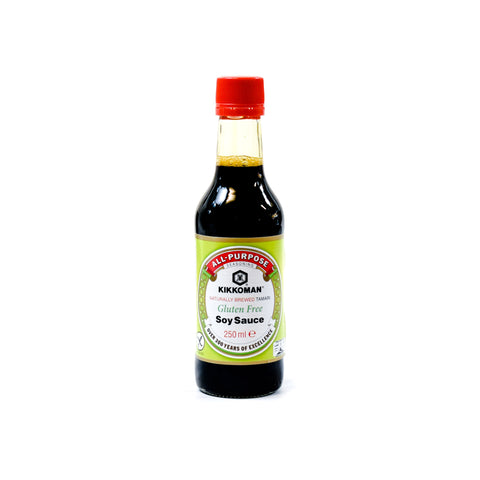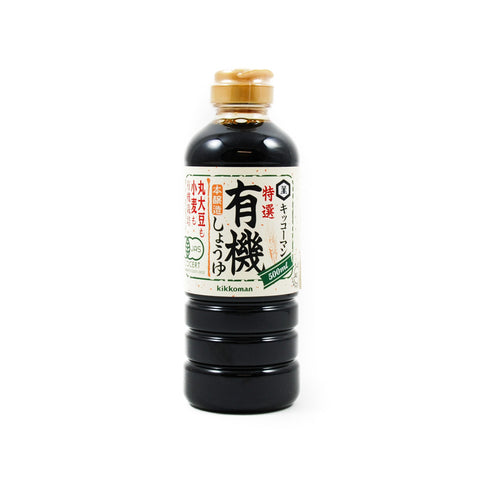Chinese & Japanese Style Soy Sauce: What's The Difference?
by The Sous Chef Team

Soy sauce is one of those ingredients that we’ve probably all got in our cupboards. Some of us may have two bottles – a light and a dark – and think that’s all there is to it. But in fact, Chinese style soy sauce is different to Japanese style soy sauce. And there’s even more variety within each style!
We’ve compared soy sauces from two of the biggest and most well-known soy sauce manufacturers: Pearl River Bridge from China, and Kikkoman from Japan.
Read on to find out the differences between Chinese and Japanese style soy sauces, the varieties within each style, and how to use each one for the best result.
Chinese Style Soy Sauce
Chinese style soy sauces are usually brewed for a few weeks with soybeans, salt, wheat and water. After brewing, caramel colouring may be added to give the sauce its distinctive dark colour. Chinese style soy sauces are often used for colour rather than flavour. ‘Light’ and ‘dark’ refer to the colour of the sauce, not how salty it is. In fact, a Chinese style light soy sauce can taste saltier than a dark one!
Pearl River Bridge is possibly the most famous Chinese seasoning brand in the world. It was established in 1958, and Pearl River Bridge seasonings were the products of choice for homesick Chinese people living overseas. It’s now a famous symbol of authentic Asian food all over the world.
In fact, Pearl River Bridge became so synonymous with quality that copy-cat companies started appearing. Pearl River Bridge now have to put special holograms on their labels so people can tell they’re getting the real thing!
Here we take you through some Chinese style soy sauces from Pearl River Bridge:
Nose: strong, almost pungent, vegetal notes like beans
Colour: clear, amber-gold
Palate: intensely salty, yet sweet and almost juicy
Use: in dishes where you don’t want much colour. Try stir frying vegetables or marinating fish. Superior light soy sauce is also a great choice for dipping wontons, spring rolls and seafood. Use in traditional Chinese recipes such as this Chinese Clay Pot Chicken.
Nose: bold and intense, with an almost alcohol-like sharpness
Colour: opaque, very dark red-black, thick syrupy consistency
Palate: intense sour-bitterness straight away, with strong umami depth that lingers for a long time on the tongue
Use: for dishes where you want lots of colour, like red-braised dishes. Try stir frying chicken or pork, or marinating beef strips. This is definitely one for cooking rather than dipping. Try in this slow-braised red beancurd pork belly & potato dish.
Nose: surprisingly subtle, but with distinct vegetable notes as of beans or cabbage
Colour: very dark, rusty brown, syrupy consistency
Palate: mellow, salty-sweet with a long umami finish
Use: in dishes where you want lots of colour, so superior dark mushroom soy sauce is also a good choice for red-braised dishes. Try the mellower flavours in a noodle soup as well as stir fries and marinades, for umami depth that keeps on going! Recommended by Fuchsia Dunlop again and again.
Nose: surprisingly fragrant and ‘fresher’ than the other Pearl River Bridge soy sauces. Distinct ‘baked beans’ notes
Colour: very clear, pale amber, almost like a sherry
Palate: intensely salty, but with a sweetness towards the finish that’s reminiscent of a tomato sauce
Use: in dishes where soy sauce is the main flavour. This is one of the highest quality Chinese style light soy sauces, so use more for dipping than cooking, or to finish a dish before serving.
Japanese Style Soy Sauce
Japanese style soy sauces, also known as shoyu, are usually brewed for months rather than weeks, and may be aged for even longer to develop the flavour. Generally, Japanese soy sauces are brewed with less salt than their Chinese style counterparts. Roasted wheat and a mixture of yeast and fungal cultures – also known as koji – are key ingredients in Japanese soy sauce. Colourings are rarely, if ever, used.
In Japan, soy sauce is used as much for flavour as for colour, if not more so. Aside from the production method, this is probably the biggest difference between Chinese style and Japanese style soy sauce.
The Kikkoman company is a giant in the world of soy sauce. They’ve been brewing the condiment for nearly 400 years, and they gained world fame in the 1800s after exhibiting at the Amsterdam and Vienna World Expos.
Today, Kikkoman is the official supplier of soy sauce to the Japanese imperial court and well-known all over the world. Aside from the scale of their operation, their natural brewing methods have changed very little since the 17th century.
Nose: deep & earthy, rounded
Colour: clear, orangey-brown
Palate: intensely salty to start, sweet middle with a taste that lingers for a long time
Use: as an everyday soy sauce for dipping sushi, dumplings, rice and noodles. Great to keep on the table and add as a finishing touch to all Japanese dishes. You’ll recognise this Japanese style soy sauce from sushi restaurants, as it’s a good all-rounder. Check out our guide to How to Make Sushi: Maki Rolls Step-by-Step, and serve the rolls with this soy sauce at the table.
Nose: mellow & fruity, almost like a red wine
Colour: clear, golden orange
Palate: intensely salty start, mellows out with a very long, very smooth umami finish
Use: in dishes where you want real depth of umami, but with a mellower flavour than other soy sauces. Try in soups and marinades, particularly with pork and beef. The smoothness of this Japanese style soy sauce is down to the fact that whole soy beans are used to brew it, rather than chopped ones.
As a result, the brewing process has to be longer to draw out all the flavour. The slow extraction gives the flavours a chance to mellow – you’ll really notice the difference. Use it as the main soy sauce in seasoning this Korean Bibimbap recipe, where the vegetables are lightly dressed with soy sauce and sesame oil - and the rich soy sauce flavour keeps its own next to the heavily spiced gochujang.
Nose: delicate, fragrant
Colour: clear, golden orange
Palate: bright & salty, subtle umami with balanced sweetness
Use: for dipping sushi and sashimi. Soy sauce is often pasteurised to increase the shelf life, but this sacrifices the subtler, more fragrant aspects of soy sauce. Unpasteurised soy sauce is best enjoyed with very simple dishes. Cooking can spoil these flavours, so use only as a dipping sauce or a dressing for plain rice, seaweed salads or fresh seafood. It was only as recently as 2010 that Kikkoman started marketing raw, unpasteurised soy sauce. This was largely down to the problem of storage. The fresh, delicate flavour of unpasteurised soy sauce may be highly sought after, but it doesn’t last very long. At last, Kikkoman developed a special squeezy bottle with a non-return valve cap. It lets soy sauce out, but doesn’t let air in. So now you can enjoy the flavour of fresh Japanese style soy sauce for at least 90 days after opening! It’s certainly worth trying – you’ll not look at soy sauce in the same way again.
Try this in a wakame and cucumber salad recipe, where the soy sauce isn't cooked - and the delicate flavours can shine through.
Nose: aromatic like perfume, but with miso-like depth on the nose
Colour: very clear, pale golden brown
Palate: very lightly salty with a sharpness from the added vinegar that lifts the soy sauce, long lasting finish
Use: as an everyday, gluten free alternative to most soy sauces. The tamari gluten free soy sauce works with chicken, fish, and vegetables and even salad dressings. This sauce has less depth than other soy sauces. The light, delicate flavour may get lost during cooking, so favour it as a finishing seasoning.
Nose: mild & salty, reminiscent of seaweed
Colour: very dark, almost black
Palate: surprisingly pungent, almost like a Chinese style dark soy sauce, salty with a flavour that lingers a long time
Use: in cooking, especially stir fries. This is a robust soy sauce that benefits from being cooked, and is a good match for green vegetables like spinach and pak choi. Avoid using this for dipping, as the flavour could be overpowering.
If you’ve tried any of the soy sauces above and you have tasting notes of your own, please pop them in the comments below – that way we can continue to build up our resources on the different aromas and flavours of all these fantastic soy sauces.
Browse our Soy Sauce Category to find these and even more soy sauces from Japanese and Chinese cuisine. Or how about Shaoxing rice wine, which is often used with soy sauce in classic Chinese marinades and dipping sauces.

About the author
The Sous Chef team spends all day, every day hunting out the most exciting flavours, trends and recipes from across the world.
Every single team member tastes ingredients weekly, and cooks with the most up-to-date and classic cooking tools regularly. We're experts in ingredients and cookware from around the world.
We are constantly tasting new products, trying new recipes, and speaking to expert producers. For recipes and inspiration from the Sous Chef team, sign up for emails here.
